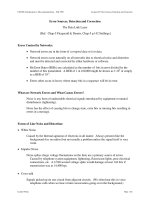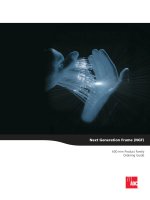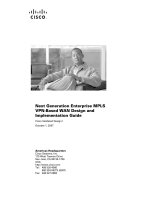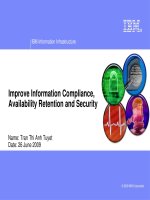Tài liệu Next Generation Mobile Systems 3G and Beyond doc
Bạn đang xem bản rút gọn của tài liệu. Xem và tải ngay bản đầy đủ của tài liệu tại đây (5.76 MB, 406 trang )
Next Generation Mobile Systems
3G and Beyond
Next Generation Mobile Systems
3G and Beyond
Edited by
Minoru Etoh
DoCoMo Communications Laboratories USA
Copyright 2005 John Wiley & Sons Ltd, The Atrium, Southern Gate, Chichester,
West Sussex PO19 8SQ, England
Telephone (+44) 1243 779777
Email (for orders and customer service enquiries):
Visit our Home Page on www.wiley.com
All Rights Reserved. No part of this publication may be reproduced, stored in a retrieval system or transmitted in
any form or by any means, electronic, mechanical, photocopying, recording, scanning or otherwise, except under
the terms of the Copyright, Designs and Patents Act 1988 or under the terms of a licence issued by the
Copyright Licensing Agency Ltd, 90 Tottenham Court Road, London W1T 4LP, UK, without the permission in
writing of the Publisher. Requests to the Publisher should be addressed to the Permissions Department, John
Wiley & Sons Ltd, The Atrium, Southern Gate, Chichester, West Sussex PO19 8SQ, England, or emailed to
, or faxed to (+44) 1243 770620.
This publication is designed to provide accurate and authoritative information in regard to the subject matter
covered. It is sold on the understanding that the Publisher is not engaged in rendering professional services. If
professional advice or other expert assistance is required, the services of a competent professional should be
sought.
Other Wiley Editorial Offices
John Wiley & Sons Inc., 111 River Street, Hoboken, NJ 07030, USA
Jossey-Bass, 989 Market Street, San Francisco, CA 94103-1741, USA
Wiley-VCH Verlag GmbH, Boschstr. 12, D-69469 Weinheim, Germany
John Wiley & Sons Australia Ltd, 33 Park Road, Milton, Queensland 4064, Australia
John Wiley & Sons (Asia) Pte Ltd, 2 Clementi Loop #02-01, Jin Xing Distripark, Singapore 129809
John Wiley & Sons Canada Ltd, 22 Worcester Road, Etobicoke, Ontario, Canada M9W 1L1
Wiley also publishes its books in a variety of electronic formats. Some content that appears
in print may not be available in electronic books.
Library of Congress Cataloging-in-Publication Data
Next generation mobile systems 3G and beyond / edited by Minoru Etoh.
p. cm.
ISBN-13 978-0-470-09151-7 (cloth)
ISBN-10 0-470-09151-7 (cloth)
1. Wireless communication systems – Technological innovations. 2. Cellular
telephone systems – Technological innovations. 3. Mobile communication
systems – Technological innovations. I. Etoh, Minoru.
TK5103.2.N4453 2005
621.3845
6–dc22
2005003372
British Library Cataloguing in Publication Data
A catalogue record for this book is available from the British Library
ISBN-13 978-0-470-09151-7 (HB)
ISBN-10 0-470-09151-7 (HB)
Typeset in 10/12pt Times by Laserwords Private Limited, Chennai, India
Printed and bound in Great Britain by Antony Rowe Ltd, Chippenham, Wiltshire
This book is printed on acid-free paper responsibly manufactured from sustainable forestry
in which at least two trees are planted for each one used for paper production.
To all the people who are collaborating with us
Contents
Foreword xiii
Preface xv
Acknowledgments xix
List of Contributors xxi
I A Vision for the Next Generation 1
1 Evolution of Mobile Networks and Services 3
1.1 TheEvolutionofMobileNetworks 4
1.2 TrendsinMobileServices 6
1.3 WhyNext-generation(XG)MobileSystems? 9
1.4 Next-generationImperatives 16
1.4.1 Radio Access Networks (RAN) . . . . . . . . . . . . . . . . . . . . 17
1.4.2 IP Backbone . . . . . . . . . . . . . . . . . . . . . . . . . . . . . . 17
1.4.3 UbiquitousServicePlatform 17
2 The All-IP Next-generation Network Architecture 19
2.1 Introduction . . . . . . . . . . . . . . . . . . . . . . . . . . . . . . . . . . . 19
2.2 3GArchitectures 20
2.2.1 UMTS 21
2.2.2 CDMA2000 . . . . . . . . . . . . . . . . . . . . . . . . . . . . . . 33
2.2.3 MWIF 36
2.2.4 Limitationsof3GArchitectures 39
2.3 Approach to a Next-generation Architecture . . . . . . . . . . . . . . . . . 44
2.3.1 RationaleandKeyFeatures 44
2.3.2 ArchitectureOverview 50
2.4 Conclusions 53
viii CONTENTS
II Overview of Mobile Network Technologies 55
3 Radio Access Technologies in Cellular Networks 57
3.1 Introduction . . . . . . . . . . . . . . . . . . . . . . . . . . . . . . . . . . . 57
3.1.1 Current Radio Access Technologies . . . . . . . . . . . . . . . . . . 57
3.1.2 Evolving Radio Access Technologies . . . . . . . . . . . . . . . . . 58
3.2 Background of Radio Access Technologies . . . . . . . . . . . . . . . . . . 59
3.2.1 Propagation Characteristics in Mobile Environments . . . . . . . . . 59
3.2.2 Basic Multiple Access Schemes in Cellular Systems . . . . . . . . . 60
3.2.3 PrinciplesofDS-CDMAandIS-95 62
3.3 Radio Access Technologies in Wideband CDMA . . . . . . . . . . . . . . . 64
3.3.1 W-CDMA 64
3.3.2 Spreading Codes and Asynchronous Operation . . . . . . . . . . . . 66
3.3.3 Orthogonal Multi-SF Downlink . . . . . . . . . . . . . . . . . . . . 67
3.3.4 TurboCodes 69
3.3.5 CoherentRakeCombining 70
3.3.6 TransmissionPowerControl 70
3.4 High-speed Transmission Technologies in HSDPA . . . . . . . . . . . . . . 72
3.4.1 Adaptive Modulation and Coding . . . . . . . . . . . . . . . . . . . 72
3.4.2 HybridARQ 76
3.4.3 FastCellSelection 78
3.5 Radio Access Technologies for Next-generation Systems . . . . . . . . . . 78
3.5.1 TechnicalRequirements 79
3.5.2 Potential Solutions for Downlink Transmission . . . . . . . . . . . . 79
3.5.3 Potential Solutions for Uplink Transmission . . . . . . . . . . . . . 81
3.6 Broadband Radio Access Schemes for XG Systems . . . . . . . . . . . . . 83
3.6.1 VSF-OFCDM for Downlink Transmission . . . . . . . . . . . . . . 83
3.6.2 VSCRF-CDMA for Uplink Transmissions . . . . . . . . . . . . . . 88
3.7 Conclusions 91
4 Wireless LAN Evolution 93
4.1 Introduction . . . . . . . . . . . . . . . . . . . . . . . . . . . . . . . . . . . 93
4.1.1 OverviewofCurrentWLANStandards 94
4.2 Basic Technologies in IEEE 802.11 WLAN . . . . . . . . . . . . . . . . . . 97
4.2.1 MAC Technologies . . . . . . . . . . . . . . . . . . . . . . . . . . . 97
4.2.2 PHY Technologies . . . . . . . . . . . . . . . . . . . . . . . . . . . 102
4.3 EvolutionofWLAN 105
4.3.1 Higher Data Rates and Low Power Consumption . . . . . . . . . . 107
4.3.2 Extended Coverage Areas and Scalability . . . . . . . . . . . . . . . 107
4.3.3 Coexistence of Access Devices . . . . . . . . . . . . . . . . . . . . 108
4.3.4 Seamless Mobility Support . . . . . . . . . . . . . . . . . . . . . . 108
4.3.5 LocationEstimationbyWLAN 109
4.3.6 Differentiated Services Support . . . . . . . . . . . . . . . . . . . . 110
4.3.7 Quality of Service Assurance for Real-time Applications . . . . . . 110
4.3.8 EnhancedSecurity 110
CONTENTS ix
4.4 Mobility Support . . . . . . . . . . . . . . . . . . . . . . . . . . . . . . . . 111
4.4.1 FastChannelScanning 111
4.4.2 FastAuthentication 114
4.5 Quality of Service . . . . . . . . . . . . . . . . . . . . . . . . . . . . . . . 121
4.5.1 EDCAandHCCA 121
4.6 Security 125
5 IP Mobility 129
5.1 Introduction . . . . . . . . . . . . . . . . . . . . . . . . . . . . . . . . . . . 129
5.2 TheInternetArchitecture 131
5.2.1 TheEnd-to-endPrinciple 131
5.2.2 InternetArchitecturalElements 132
5.2.3 IP Addresses and Routing Topologies . . . . . . . . . . . . . . . . . 132
5.2.4 FullyQualifiedDomainNamesandDNS 133
5.3 Network Layer Mobility in the Internet . . . . . . . . . . . . . . . . . . . . 134
5.3.1 BasicMobileIP 134
5.3.2 RoutingInefficiencies 136
5.3.3 Mobile IP Handover . . . . . . . . . . . . . . . . . . . . . . . . . . 138
5.3.4 AAAandSecurity 142
5.4 Achieving Seamless Mobility . . . . . . . . . . . . . . . . . . . . . . . . . 150
5.4.1 HeaderCompression 151
5.4.2 ContextTransfer 152
5.4.3 Intertechnology Handover . . . . . . . . . . . . . . . . . . . . . . . 154
5.4.4 Candidate Access Router Discovery (CARD) . . . . . . . . . . . . . 154
5.5 Summary 156
6 APIs and Application Platforms for Next-generation Mobile Networks 157
6.1 Introduction . . . . . . . . . . . . . . . . . . . . . . . . . . . . . . . . . . . 157
6.2 Background . . . . . . . . . . . . . . . . . . . . . . . . . . . . . . . . . . . 158
6.2.1 ServiceCreationinthePSTN 158
6.2.2 ServiceCreationintheInternet 159
6.2.3 Service Creation in Converged Networks . . . . . . . . . . . . . . . 159
6.2.4 TypesofAPIs 160
6.2.5 APIsVersusProtocols 161
6.2.6 Programming Languages . . . . . . . . . . . . . . . . . . . . . . . . 161
6.3 StandardTelecommunicationsAPIs 162
6.3.1 Parlay 163
6.3.2 JAIN 168
6.3.3 Open Mobile Alliance (OMA) . . . . . . . . . . . . . . . . . . . . . 174
6.4 AdvancedAPIEfforts 176
6.4.1 Parlay Web Services and Parlay X Web Services . . . . . . . . . . 176
6.4.2 RouterAPIs 178
6.5 OurApproach 180
6.5.1 LayeredAPIDesign 180
6.5.2 ContentDeliveryNetworkAPI 182
6.6 DiscussionandConclusions 185
x CONTENTS
III Middleware and Applications 189
7 Terminal Software Platform Technologies 191
7.1 Introduction . . . . . . . . . . . . . . . . . . . . . . . . . . . . . . . . . . . 191
7.1.1 GenericTerminalSoftwarePlatform 192
7.1.2 Terminal Software Platform Evolution . . . . . . . . . . . . . . . . 193
7.2 ExistingTerminalSoftwarePlatforms 195
7.2.1 SymbianOS 195
7.2.2 PalmOS 197
7.2.3 Windows CE .NET . . . . . . . . . . . . . . . . . . . . . . . . . . . 197
7.2.4 QUALCOMM BREW . . . . . . . . . . . . . . . . . . . . . . . . . 199
7.2.5 SoftwarePlatformComparison 200
7.3 RuntimeEnvironments 200
7.3.1 SunJava 200
7.3.2 Microsoft.NETCompactFramework 203
7.3.3 Benefits of Runtime Environments for Mobile Handsets . . . . . . . 204
7.4 Terminal Software Platform Security: Trusted Computing Group . . . . . . 204
7.4.1 TCGSpecificationsOverview 205
7.4.2 Trusted Computing Group and Mobile Devices . . . . . . . . . . . 207
7.5 Terminal Software Platform Management: Over the Air Provisioning . . . . 207
7.5.1 Open Mobile Alliance . . . . . . . . . . . . . . . . . . . . . . . . . 207
7.5.2 OvertheAirSoftwareUpdating 208
7.6 ResearchDirections 209
7.6.1 TerminalMiddlewareServices 210
7.6.2 Mervlets: Leveraging the Web Model . . . . . . . . . . . . . . . . . 218
7.7 Conclusions 223
8 Multimedia Coding Technologies and Applications 225
8.1 Introduction . . . . . . . . . . . . . . . . . . . . . . . . . . . . . . . . . . . 225
8.2 Speech and Audio Coding Technologies . . . . . . . . . . . . . . . . . . . . 227
8.2.1 Speech Coding Standards . . . . . . . . . . . . . . . . . . . . . . . 228
8.2.2 PrinciplesofAudioCoding 233
8.2.3 AudioCodingStandards 238
8.2.4 Speech and Audio Coding Issues . . . . . . . . . . . . . . . . . . . 241
8.2.5 FurtherResearch 242
8.3 Video Coding Technologies . . . . . . . . . . . . . . . . . . . . . . . . . . 244
8.3.1 PrinciplesofVideoCoding 245
8.3.2 VideoCodingStandards 246
8.3.3 VideoCodingIssues 249
8.3.4 FurtherResearch 249
8.4 Mobile Multimedia Applications . . . . . . . . . . . . . . . . . . . . . . . . 250
8.4.1 Mobile TV Phone . . . . . . . . . . . . . . . . . . . . . . . . . . . 250
8.4.2 Multimedia Messaging Service . . . . . . . . . . . . . . . . . . . . 252
8.4.3 FutureTrends 252
CONTENTS xi
9 Wireless Web Services 257
9.1 Introduction . . . . . . . . . . . . . . . . . . . . . . . . . . . . . . . . . . . 257
9.1.1 EmergingWebServices 258
9.1.2 Web Services Definition . . . . . . . . . . . . . . . . . . . . . . . . 258
9.1.3 WebServicesModel 259
9.2 WebServicesArchitecture 260
9.2.1 WebServicesStack 260
9.3 Web Service Technologies for Small Wireless Devices . . . . . . . . . . . . 262
9.3.1 Communication Technologies . . . . . . . . . . . . . . . . . . . . . 265
9.3.2 The Base Technology – XML . . . . . . . . . . . . . . . . . . . . . 266
9.3.3 Messages–SOAPanditsExtensions 268
9.3.4 Web Services Discovery (UDDI) . . . . . . . . . . . . . . . . . . . 270
9.3.5 WebServicesDescription(WSDL) 274
9.3.6 Web Services Execution and Process . . . . . . . . . . . . . . . . . 275
9.3.7 J2MEWebServicesSpecification–JSR172 279
9.3.8 ResearchonWirelessWebServices 279
9.4 Web Services and the Open Mobile Alliance . . . . . . . . . . . . . . . . . 281
9.4.1 WebServicesinOMA 281
9.4.2 Location-aware Messaging Service (LMS) . . . . . . . . . . . . . . 282
9.5 Conclusion 282
IV Security 283
10 Cryptographic Algorithms and Protocols for XG 285
10.1 Introduction . . . . . . . . . . . . . . . . . . . . . . . . . . . . . . . . . . . 285
10.1.1 TheChallengeofSecuringXG 286
10.1.2 ChapterOverview 287
10.2Secret-keyCryptography 287
10.2.1 SomeHistory 288
10.2.2 GSM 289
10.2.3 3GPP and Kerckhoff’s Principle . . . . . . . . . . . . . . . . . . . . 291
10.3Public-keyCryptography 291
10.3.1 Some History and Well-known Schemes . . . . . . . . . . . . . . . 292
10.3.2 CertificationofPublicKeys 294
10.3.3 SSL 295
10.4Public-keyInfrastructure 296
10.4.1 Hash-basedCertification 297
10.4.2 Certificate-basedEncryption 297
10.4.3 Identity-based Cryptography . . . . . . . . . . . . . . . . . . . . . . 298
10.5ProvingthataCryptosystemisSecure 299
10.5.1 TheProvableSecurityParadigm 300
10.5.2 Example: The Rabin Signature Scheme . . . . . . . . . . . . . . . . 301
10.6 Advanced Functionalities and Future Directions . . . . . . . . . . . . . . . 303
10.6.1 Electronic Cash and Other Privacy-preserving Protocols . . . . . . . 303
xii CONTENTS
10.6.2 CopingwithHeterogeneity 308
10.6.3 Efficient Cryptographic Primitives . . . . . . . . . . . . . . . . . . . 311
10.6.4 Cryptography and Terminal Security . . . . . . . . . . . . . . . . . 312
10.6.5 OtherResearchDirections 313
10.7Conclusion 314
11 Authentication, Authorization, and Accounting 315
11.1EvolutionofAAA 316
11.2CommonAAAFramework 317
11.3 Technologies . . . . . . . . . . . . . . . . . . . . . . . . . . . . . . . . . . 319
11.3.1 RADIUSandDiameter 320
11.3.2 ExtensibleAuthenticationProtocol 321
11.3.3 PANA 323
11.3.4 WLAN 328
11.3.5 IP-basedCellularNetworks 334
11.4EmergingResearch 338
11.4.1 AAA for Access Networks with Ad hoc Extensions . . . . . . . . . 338
11.4.2 802.11i Handover Optimizations . . . . . . . . . . . . . . . . . . . 340
11.4.3 UnifiedAAA 341
12 Security Policy Enforcement for Downloaded Code 345
12.1 Introduction . . . . . . . . . . . . . . . . . . . . . . . . . . . . . . . . . . . 345
12.2StandardDynamicMonitors:Java2 347
12.2.1 Stack-inspecting Dynamic Monitors . . . . . . . . . . . . . . . . . . 349
12.3SelectiveDynamicMonitors 350
12.3.1 Wallach et al.: Capabilities and Namespaces . . . . . . . . . . . . . 351
12.3.2 Erlingsson and Schneider: Security Automata . . . . . . . . . . . . 351
12.3.3 Evans and Twyman: Abstract Operating Systems . . . . . . . . . . 351
12.3.4 PandeyandHashii:Benchmarks 352
12.3.5 Kim et al.: Languages of Events . . . . . . . . . . . . . . . . . . . 352
12.3.6 Chander et al.: Renaming Classes and Methods . . . . . . . . . . . 353
12.3.7 Ligattietal.:EditAutomata 353
12.3.8 Colcombet and Fradet: Minimizing Security Automata . . . . . . . 353
12.4StaticSecurityManagers 354
12.4.1 Gosling et al.: Java Bytecode Verifier . . . . . . . . . . . . . . . . . 355
12.4.2 Morrisett et al.: Typed Assembly Language . . . . . . . . . . . . . 355
12.4.3 Xi:DependentTypes 355
12.4.4 Crary and Weirich: Dependent Types . . . . . . . . . . . . . . . . . 355
12.4.5 NeculaandLee:Proof-carryingCode 356
12.4.6 Sekaretal.:Model-carryingCode 356
12.4.7 Xia and Hook : Abstraction-carrying Code . . . . . . . . . . . . . . 356
12.4.8 Fitzgerald et al.: The Marmot Java Compiler . . . . . . . . . . . . . 357
12.5Conclusion 357
Bibliography 359
Index 377
Foreword
Thoughts on the XG system
The growth of the Internet, which I have been involved in, and the growth of mobile
telephone services, which NTT DoCoMo has been a leader in, have been peculiarly inter-
linked and at the same time separate. The Internet is a lab experiment that broke free, and
finds itself in a world of its own contriving, which it often does not understand. The mobile
telephone world was developed for commercial purposes, and is in many respects the son of
its father, the wired telephone system. Each seeks to bring innovative services to its users.
The two intertwine in interesting ways. Research done in the 1990s developed a way
for Internet end systems to break free of their wired moorings, resulting in what we call
IP Mobility, mobility in the Internet layer. Two logical users of this soon developed: the
nomadic laptop driving down the street might connect to a wireless LAN, and the mobile
telephone that acquired services reminiscent of that same laptop.
Both move, and both have a need to be able to participate in peer-to-peer sessions, but
they serve different needs. The laptop is, in the final analysis, something we use because
its screen size and general ubiquity make it a reasonable replacement for the desk-mounted
system left behind, but we would not think of it as a personal communications device. If
nothing else, if I attach mine to my belt, it will soon either be damaged itself or damage
my belt. The mobile telephone fits my belt well, and is very appropriate as a personal
communications device. But if I were to try to write these thoughts on my telephone, I
would soon go crazy. The instrument is not suited to the application. Both do electronic
mail, but one is for megabyte attachments and the other for pithy messages or instant
messaging. Both do calendaring, but one easily lets me see a month at a glance, while the
other is more suited to managing my day. They are tools, both of them, suited to their own
uses, and using in many respects common technology.
The development of mobility has worked its way back into the wired Internet in inter-
esting ways. As we develop and deploy the concepts of Anycast Routing, in which a set of
computers collaborate to offer a service, and I use Internet routing to attach to whichever
happens to be closest at the moment, IP Mobility solves a problem for a stationary system.
If I open a TCP connection to the nearest computer in an Anycast service, and then either
I move or routing changes, I might find myself talking to another server without warning.
Since the state I shared with the first is unknown to the second, I lose everything I have
done to that point and must start over. But, if I treat the Anycast address as the Home
Address of a mobile node and then use Optimized Routing to tie the mobile session to the
particular server as a Care-of Address, my session remains stable even as routing changes.
Treating the stationary node as a mobile node solves a difficult application problem.
xiv FOREWORD
To understand the network, one must, I think, grasp it at many layers simultaneously.
One must understand the implications of the transmission layers, physical and link, and the
intranetworking layer that builds a network of like systems under a common administration.
One must go on to understand how these intranets interconnect at the Internet layer, and how
various transports use them and respond to their anomalies. In the end, one must understand
and be prepared to deal with the requirements of the application and the user who uses it.
This is true because, in the end, the networked device, and the user, looks no further than
the application concerned. The network must make that application work well for the user,
or find another reason to exist.
I found myself, recently, thinking of ways to use the wired, wireless, and mobile Inter-
nets together. In December 2004, a tsunami swept hundreds of thousands of people – we
may never really know how many – to their deaths, and the Internet community asked “how
might we have helped?” The answer turns out to use interesting aspects of both types of
communication systems. A Tsunami Warning Center, had one existed (as one does in the
mid-Pacific) in the Indian Ocean, might have encoded a message using the Common Alert-
ing Protocol, which is an information model for agency-to-agency distributions regarding
disasters. They would have sent this message in any number of ways to subscribing centers
run by appropriate authorities in various countries. Many of those would be by Internet – the
web, RSS feeds, authenticated electronic mail, and so on. These centers would then con-
sider what areas are likely to be affected, the level of urgency, certainty, and severity, and
what the appropriate message might be, and then sent the message on to citizens likely
to be affected. An obvious way to locate the people in a locality is to ask if their mobile
telephone is registered in the cell in the locality. An obvious way to get their attention is to
call each such registered telephone with a voice message, or to send a text message using
cell broadcast, as is available in GSM and being deployed in Europe. The Internet and the
mobile telephone system each are then used to distribute a message from a regional center
through a crisis management agency, and finally to a person sleeping on the beach or in the
projected path of a storm.
The authors collaborating on this work have tried to step aside from the marketing ter-
minology of “next generation”, to think about what kinds of systems they would really like
to deploy, and why they would deploy them. To their credit, they have not thought of their
system as taking over the world, as many in our industry do when they dream up new tech-
nologies. It is enough to find one’s place in the world and serve a targeted set of needs well.
In this book, they have explored the kinds of applications that will adapt well to a personal
communication device. They have considered the kinds of transports these applications will
use, how they interact with the rest of the Internet, and how they interact with the peculiar
transmission systems – radios of various kinds – used in the mobile telephone world, and
the aspects and algorithms of mobility that enhance that experience.
They point us in an interesting direction. And for that, I thank them.
Fred Baker
Cisco Fellow, California
Preface
The aim of this book is not to describe new wireless access technologies that will replace the
third generation (3G) technologies, but to describe a complete ecosystem of technologies,
including access technologies that will be essential for the development of a new mobile
environment beyond the 3G era. The mobile applications currently envisioned for this future
platform will be augmented by others that will arise because of the innovative opportunities
offered by the new environment, and will change the nature of the mobile communications
business.
Daily life is becoming increasingly dependent on mobile communication. This trend
began with the first mass uptake of cellular telephones in the mid-1980s and continues
with evermore diverse services being offered by a growing number of operators. There is
every indication that this trend will continue and even accelerate as networks become more
powerful and devices become more ubiquitous.
Throughout the evolution of the mobile network industry, mobile networks have been
nominally characterized by the generation of their wireless access technology. At the time
of publishing, year 2005, it is commonly accepted that there have been three generations of
wireless technology, called 1G, 2G, and 3G.
The third generation was officially launched by NTT DoCoMo, Inc. in October 2001,
and is, in effect, the “current generation,” although we are early in this generation’s predicted
life cycle. Third-generation wireless technology is well defined, and devices that use 3G
technology are entering, and even becoming commonplace in, the market.
Wireless connectivity, simple speech services, and computing devices are becoming
commodities. The user community now demands evermore powerful functionality and con-
tinuously improving applications. This new and more sophisticated user demand is driving
the research community to look toward the future of wireless networks. As a result, mobile
communication researchers are starting to focus on the technology required for the next
generation of mobile systems. This new focus creates a need for the research community
to begin a dialogue about the future of mobile networks and communications. Throughout
this book, we use the term “Next-generation (XG) mobile systems” to describe a complete
mobile communication system beyond 3G that includes the whole technology “value chain”
of future wireless networks. Our definition of XG is complex and inclusive, from future
heterogeneous service platforms to the core network and from the heterogeneous access
network to the user terminals. On the other hand, the term “Fourth Generation” (4G) mostly
implies the fourth-generation radio access networks (RAN). The technologies required to
realize XG systems are clearly not limited to new wireless access methods, as is sometimes
xvi PREFACE
proposed. We must pay attention to a wide range of emerging and existing research topics
such as IP backbone networks, open and heterogeneous service platforms, terminal software,
and multimedia applications. It is our belief that these technologies will be implemented
and will evolve continuously, rather than suddenly, supplanting 3G technology in a revolu-
tionary way. In this sense, although the next generation can be seen as a logical evolution
of 3G, the XG image is very different and will require breakthrough technologies in many
diverse areas. We firmly believe that the future mobile world will not be defined only by
new wireless access technologies. We propose a clear distinction between two terms: the 4G
Radio Access Network (RAN) and the XG mobile system. The 4G RAN part is clearly an
important component of XG mobile systems, but it is insufficient to define it. We will dis-
cuss some existing and emerging technologies that we think are necessary for our definition
of Next Generation in this book.
NTT DoCoMo, Inc. has created a research lab specifically to work on next-generation
mobile system technology issues and to help lead the community in these discussions. The
company believes that it is timely and in the best interests of the whole industry to share
our vision of the future of the wireless networking industry, and the technologies required
to define the industry beyond the current third generation.
This book examines the issues that are currently driving technology development in the
wireless world. It surveys the technologies that are, in our opinion, most likely to become
part of the foundation for mobile systems in the post 3G era.
Each chapter covers a different technology area. The current technology base is sum-
marized, and the demands for new functionality and how these demands stress current
3G systems is discussed. Where appropriate, we employ existing standards as a tool to
describe the current status of the industry, and emerging standards as a tool to anticipate
the medium-term future. Emerging standards provide a comprehensive and commercially
neutral indication of the most likely direction of mobile systems in the medium term (five
to six years). Finally, current research is presented, including discussions about DoCoMo
Labs USA group’s research into future XG mobile system architectures.
A Note on Terminology:
The world of future wireless networking systems is dogged
by misunderstanding due to the confusing terminology that unfortunately must be used. The
difficulties arise because the same terms have different meanings depending on which side
of the Pacific or Atlantic you happen to be on. In this book, we use the following terms
with the following meanings.
Next-generation mobile system. This refers to the whole (beyond 3G) mobile communi-
cation system in its entirety, including the whole technology “value chain” of the
wireless ecosystem from the service platform, through the core and access networks
to the user terminal and applications.
Next-generation mobile network. This refers to a subset of the “Next-generation Mobile
System” defined above. The Next-generation Mobile Network includes the core
network and radio access networks only. Please note that in keeping with estab-
lished industry practice the shorthand “XG” may be substituted for the term
“Next Generation”.
PREFACE xvii
4G radio access network (or 4GRAN). This refers specifically to the radio access net-
work in the “Next-generation Mobile System”. This is the radio/wireless network
connecting the user terminal to the edge of the core network.
4G Wireless access technology. This is a reference to the technology employed in the
4GRAN and may occasionally be used in the same context as 4GRAN.
Acknowledgments
We gratefully acknowledge Takanori Utano, Chief Technical Officer in NTT DoCoMo, Inc.,
for giving us an opportunity to publish this book. We also acknowledge Candy Wong, a for-
mer employee, at present a research engineer for Mobile Software Lab, for her contribution.
The following people were extremely helpful in contributing to the chapter on 4G Radio
Access technology: Dr Keiji Tachikawa, a former president and CEO of NTT DoCoMo, Inc.
and Dr Mamoru Sawahashi, a director of the IP Radio Network Development Department
in NTT DoCoMo, Inc. We also thank John Wullert, a co-chair for the Parlay Emergency
Telecom Services (ETS) working group, as well as Steve Crowley, a member of the 3GPP2
and IEEE 802 standards bodies, for their review of the chapter on an IP-Based 4G Mobile
Network Architecture.
While it is the editor’s name that appears on the cover of the book, no book would be
possible without the combined efforts of the supporting team. We would like to extend a
word of thanks to our management and Kayoko Fujita, a PR&CS Liaison at DoCoMo
Communications Laboratories USA, Inc. for administrative support. Their encouragement
and support throughout this process is appreciated immensely.
List of Contributors
Frank Bossen, Wai Chu, David Espinosa, Minoru Etoh, Xia Gao, Craig Gentry,
Nayeem Islam, Ravi Jain, Moo Ryong Jeong, Toshiro Kawahara, James Kempf, Khos-
row Lashkari, Ged Powell, Zulfikar Ramzan, Manuel Roman, Muhammad Mukarram
Bin Tariq, Fujio Watanabe, Dong Zhou, 181 Metro Drive, Suite 300, San Jose, California
95110, USA
Xiaoning He,
Henry Song,
Gang Wu,
Alper E. Yegin,
Part I
A Vision for the Next Generation
The three generations of mobile networks deployed to date (1G, 2G, and 3G) have been
defined by their technical characteristics. Even when the essential requirements, drafted to
excite and initiate work on a new generation, were explicitly written in terms of services
(e.g., IMT-2000), the resultant systems were defined (and, unfortunately, divided) by their
access network technology.
While it is possible to characterize and differentiate the existing three generations of
wireless networks by their service provision (and this is done in Chapter 1), this is not usually
done. One of the reasons for this is the networks themselves generally offered services that
appeared to be mobile versions of services traditionally available over the PSTN, with the
emphasis on speech communication. Thus, the services themselves were not perceived as the
differentiating aspect of each network. This is changing with the possibilities for enhanced
services offered by current 3G networks and given the advanced services now deploying,
describing a network by defining some set of technical aspects of its implementation is
becoming almost meaningless.
We stand at the c08f012 of development for the next generation of mobile systems. We
argue in this book that this mobile system will not be defined by the technology used in the
access network, not least because the access network will be heterogeneous and includes
many different technologies. Further, we argue that this heterogeneity will not be confined to
the access network but will be an important aspect of the service platform layer. This argu-
ment is introduced in Chapter 1 and developed further in the second chapter. Chapter 1 lays
out a brief review of the evolution of wireless network development before projecting the
evolutionary trajectory to anticipate some key characteristics of the next generation, leading
to the definition of imperative technologies for a successful next generation deployment.
Chapter 2 deals with the architectural aspects of the push toward a commercially viable
next generation (XG) mobile network. A descriptive review of the development and imple-
mentation of the principal third-generation networks deployed today is given in the first part
of this chapter. This provides an interesting and important perspective to the second part of
the chapter, which develops some rationale and key requirements for the next generation.
Important areas, such as the need for an all IP network, an open API approach and an
accessible, ubiquitous service layer are discussed, culminating in a proposal for a general
XG mobile system architecture. A comprehensive survey of relevant standards is presented,
providing a view of current 3G technologies and allowing some educated speculation on
future directions beyond 3G.
Next Generation Mobile Systems. EditedbyDr.M.Etoh
2005 John Wiley & Sons, Ltd









